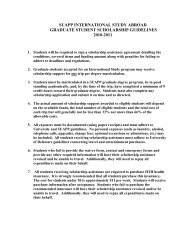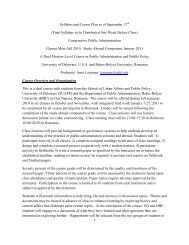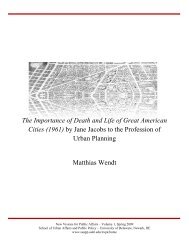New Visions for Public Affairs Volume 1 - School of Public Policy ...
New Visions for Public Affairs Volume 1 - School of Public Policy ...
New Visions for Public Affairs Volume 1 - School of Public Policy ...
You also want an ePaper? Increase the reach of your titles
YUMPU automatically turns print PDFs into web optimized ePapers that Google loves.
Mead, Hilary Bringing Equity Back 6<br />
inequities and failed to achieve their own ambitious<br />
quality goals.<br />
One reason <strong>for</strong> this failure is because so many<br />
excellence re<strong>for</strong>ms involve parental choice and these<br />
are based on strong feelings rather than carefully<br />
considered educational rationales. As Shapiro and<br />
Johnson (2005) show, the power to choose is highly<br />
differential. They examine a <strong>for</strong>m <strong>of</strong> choice, moving<br />
into “desirable” school zones, which is obviously more<br />
possible <strong>for</strong> those with wealth. Other <strong>for</strong>ms can be<br />
inequitable too; many charter schools provide no<br />
transportation, so families have to drive their children<br />
to school or live nearby (Wells, Scott, Lopez & Holme<br />
2005, p.237). Filling out applications and choice <strong>for</strong>ms<br />
takes time and language ability that many families lack.<br />
When families can exert choice, they reinscribe race<br />
and class divisions. Shapiro and Johnson (2005) noted<br />
that families base their choices not on educational<br />
quality but on school reputation, <strong>for</strong> which “Whiteness”<br />
and wealth are markers (p.251, 253). In their study <strong>of</strong><br />
vouchers in Chile, Carnoy and McEwan (2005) find<br />
that families choose the best education their money can<br />
buy: wealthy families pay tuition and middle class<br />
families use vouchers at private schools (p.278-9).<br />
These choices result in persistent cycles <strong>of</strong> inequity.<br />
What Wells et al. (2005) notice in Cali<strong>for</strong>nia is also true<br />
in Delaware: “charter schools are more segregated by<br />
race and social class than the already segregated public<br />
schools” (p.237). Because choice is construed as so<br />
problematic, the book suggests that there is no “free<br />
market” <strong>for</strong> education.<br />
The authors also demonstrate that ignoring the equity<br />
implications <strong>of</strong> an “excellence” re<strong>for</strong>m is pernicious.<br />
They suggest that re<strong>for</strong>ms need to be scrutinized <strong>for</strong><br />
potential undermining consequences. For example,<br />
charter school laws – intended to promote local control<br />
and community voice – do not provide capital funding.<br />
As a result, schools <strong>of</strong>ten operate on (or close because<br />
<strong>of</strong>) inadequate budgets, or they seek private funding,<br />
compromising their community control and creating<br />
inequities between schools with greater and lesser<br />
resources to leverage (Wells et al., 2005, p.233).<br />
Although charter schools may hold the promise <strong>of</strong><br />
culturally responsive curriculum and pedagogy,<br />
financial troubles can threaten their excellence. Despite<br />
the explosion <strong>of</strong> charter schools and the high-pr<strong>of</strong>ile<br />
successes <strong>of</strong> some charters in reducing achievement<br />
gaps, these researchers are not optimistic: “to the extent<br />
that charter schools <strong>of</strong>fer yet another layer in a highly<br />
unequal education system, they have not solved the<br />
problems faced by the students on the „bottom‟ in terms<br />
<strong>of</strong> access to better-quality education” (p.238).<br />
Bringing Equity Back also tells two other stories <strong>of</strong><br />
excellence re<strong>for</strong>ms that failed – almost naively – to<br />
consider the equity landscape they had chosen to enter.<br />
Both <strong>New</strong> American <strong>School</strong>s (NAS) and single-sex<br />
academies in Cali<strong>for</strong>nia were framed as sparking<br />
innovation and adding choices to the educational menu;<br />
they were about excellence, not equity. Yet in both<br />
cases the decision was made to direct the re<strong>for</strong>m at “atrisk”<br />
students and failing schools. According to<br />
Berends, Bodilly & Kirby (2005), many <strong>of</strong> the hurdles<br />
NAS faced in implementing its school designs can be<br />
<strong>New</strong> <strong>Visions</strong> <strong>for</strong> <strong>Public</strong> <strong>Affairs</strong> – <strong>Volume</strong> 1, Spring 2009<br />
<strong>School</strong> <strong>of</strong> Urban <strong>Affairs</strong> and <strong>Public</strong> <strong>Policy</strong> – University <strong>of</strong> Delaware, <strong>New</strong>ark, DE<br />
www.suapp.udel.edu/nvpa/home







